
The Top 20 Castles to Visit in Bulgaria
Despite its coastal regions and ski resorts being well known among foreign tourists, Bulgaria’s historical landmarks are lesser known to international tourists. When you first land in Bulgaria, it can be difficult to know where to go and how to get there if you don’t have a tour guide or a local friend who can assist you. What many people don’t know is that Bulgaria is the oldest country in Europe and is steeped in history and culture. There are so many incredible landmarks to visit and historical places of interest, if you know where to find them. We’ve put together a list of the top 20 castles to visit in Bulgaria so that you can better plan your trip this year!
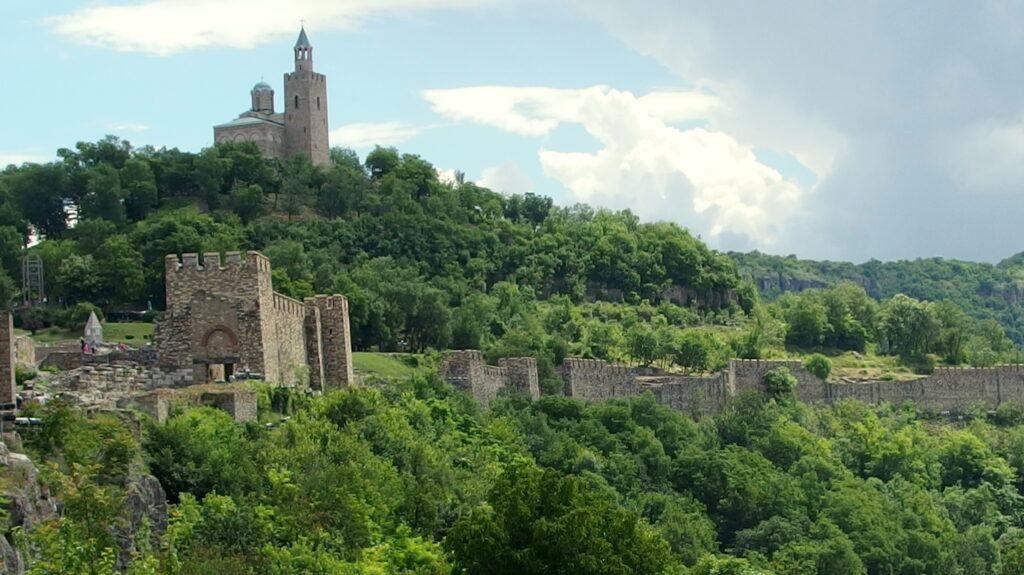
Tsarevets Castle
Tsarevets Fortress, often referred to as Tsarevets Castle, is a medieval stronghold located on a hill overlooking the city of Veliko Tarnovo in northern Bulgaria. This fortress played a crucial role in the history of the Second Bulgarian Empire. Here are key details about Tsarevets Fortress:
- Historical Significance: Tsarevets Fortress served as the primary fortress and administrative center of the Second Bulgarian Empire during the 12th to 14th centuries. It was a symbol of the political and cultural power of the Bulgarian state during this period.
- Construction: The fortress was built on the Tsarevets Hill, providing a strategic advantage with its elevated position and commanding views of the surrounding landscape. It featured thick defensive walls, towers, and a citadel. The architecture of Tsarevets is reflective of medieval Bulgarian military construction.
- Palace Complex: Within the fortress, there was a royal palace complex that included the royal residence, the patriarchal church of the Ascension of the Holy Mother of God, and other administrative buildings. The complex was a center of political and religious authority.
- Battles and Conquests: Tsarevets witnessed several battles and sieges, with one of the most notable being the Siege of Tarnovo in 1393 when the Ottoman Turks captured the fortress, marking the end of the Second Bulgarian Empire. The fall of Tsarevets symbolised the Ottoman conquest of Bulgaria.
- Execution Rock: One of the distinctive features of Tsarevets Fortress is the so-called Execution Rock, a cliff from which, according to historical accounts, traitors and criminals were thrown to their deaths as a form of punishment.
- The Patriarchal Church: The Patriarchal Church of the Ascension of the Holy Mother of God was the main church within the fortress. It was known for its religious significance and architectural beauty. The church was later destroyed during the Ottoman rule, and today, its ruins are a prominent feature of Tsarevets.
- Archaeological Excavations: Tsarevets Fortress underwent extensive archaeological excavations in the 20th century, uncovering various structures, artefacts, and remnants that provide insights into the life and culture of medieval Bulgaria.
- Sound and Light Show: Tsarevets is known for its impressive sound and light show, which takes place in the evenings. The illumination of the fortress walls and the use of music and narration create a captivating experience for visitors, bringing the history of Tsarevets to life.
Tsarevets Fortress stands as a symbol of Bulgaria’s medieval heritage and the struggles of its people during a significant period in history. The site attracts tourists and history enthusiasts, offering a glimpse into the medieval past of Veliko Tarnovo and the Second Bulgarian Empire.
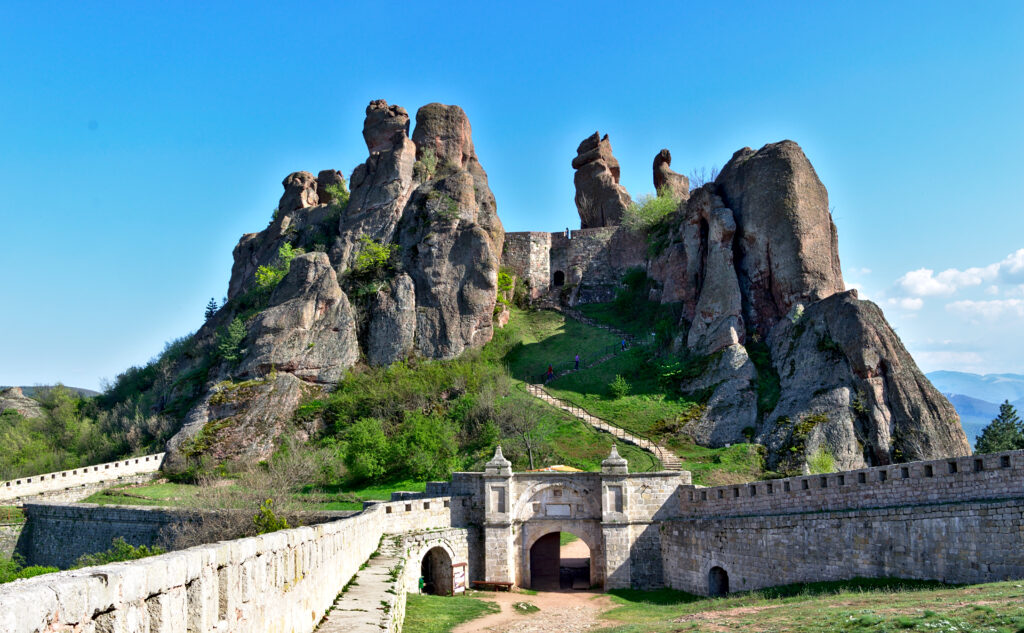
credit: Yanko Malinov
Belogradchik Fortress
Belogradchik Fortress is a remarkable historical site located near the town of Belogradchik in northwestern Bulgaria. The fortress is renowned for its unique rock formations and medieval architecture. Here are some key details about Belogradchik Fortress:
- Construction and History: Belogradchik Fortress has a long and varied history, with its origins dating back to the Roman period. The initial fortifications were constructed for defensive purposes against invasions. However, the current fortress largely took shape during the 14th to 19th centuries when the region was under Ottoman rule.
- Location: The fortress is situated on the western slopes of the Balkan Mountains, near the town of Belogradchik in the Vidin Province of Bulgaria. Its strategic location atop the natural rock formations provides a commanding view of the surrounding landscape.
- Architectural Features: The fortress is characterised by a series of stone walls and towers that wind around the rock formations, creating a visually stunning and harmonious integration with the natural landscape. The rocks themselves served as a natural defense barrier.
- Natural Wonders: One of the most intriguing aspects of Belogradchik Fortress is the surrounding rock formations, which come in various shapes and sizes. Some of the rocks have been named based on their appearance, such as the Madonna, the Horseman, and the Cuckoo. These formations, combined with the fortress, create a unique and picturesque scene.
- Cultural Significance: Belogradchik Fortress has been recognized not only for its military significance but also for its cultural importance. In 2009, it was nominated as a candidate for inclusion in the New Seven Wonders of the World.
- Tourist Attraction: Today, Belogradchik Fortress is a popular tourist destination, drawing visitors with its historical significance, architectural marvels, and the breathtaking natural setting. The site has been well-preserved, allowing visitors to explore the fortress and enjoy panoramic views of the surrounding countryside.
Belogradchik Fortress stands as a testament to Bulgaria’s rich history and is a captivating destination for those interested in the intersection of natural beauty and human ingenuity.
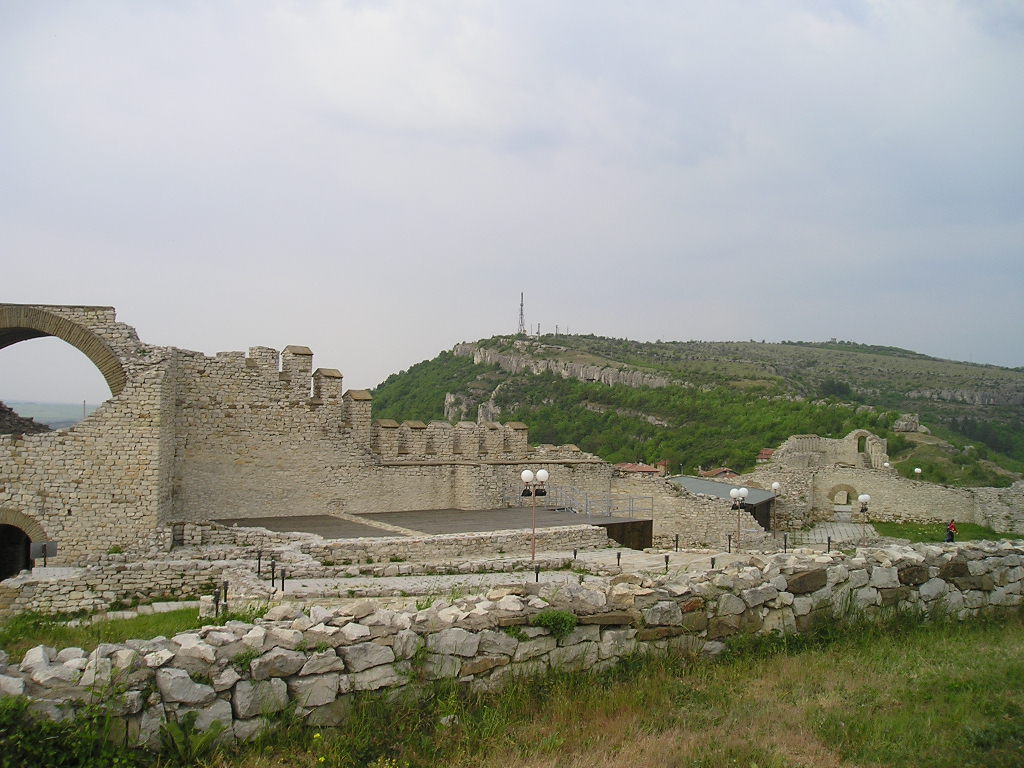
Lovech Fortress
There isn’t a well-known historical fortress specifically called “Lovech Fortress” in Bulgaria. However, Lovech is home to the Hisarya Fortress, also known as Lovech Fortress, which might be the fortress you are referring to. If you meant a different fortress, please provide additional details or clarification.
Assuming you are referring to Hisarya Fortress in Lovech, here is information about it:
Hisarya Fortress (Lovech Fortress):
- Location: Hisarya Fortress is located on the territory of Lovech, a city in north-central Bulgaria. Lovech is known for its rich history and picturesque setting along the Osam River.
- History: Hisarya Fortress has ancient origins, dating back to Roman times. It was initially established as a Roman fortification due to its strategic location. The fortress underwent various modifications and expansions under different rulers, including the Byzantines and Bulgarians.
- Architectural Features: The fortress is situated on the top of a hill, providing a commanding view of the surrounding area. It features typical medieval defensive structures, including walls, towers, and gates. The architecture reflects the various periods of construction and renovation.
- Cultural Importance: Hisarya Fortress has cultural and historical significance, representing the complex history of the region. The site has witnessed different civilisations and historical events, contributing to its importance in Bulgarian heritage.
- Medieval Period: During the medieval period, Hisarya Fortress played a role in the defence of Lovech and the surrounding territories. It was part of the defensive network in the region.
- Archaeological Discoveries: Archaeological excavations around Hisarya Fortress have uncovered artefacts and structures that shed light on the life and activities of people who inhabited the area during different historical periods.
- Tourist Attraction: Today, Hisarya Fortress is open to visitors and is a popular tourist attraction in Lovech. The site offers a glimpse into Bulgaria’s medieval past and provides panoramic views of the city and the surrounding landscapes.
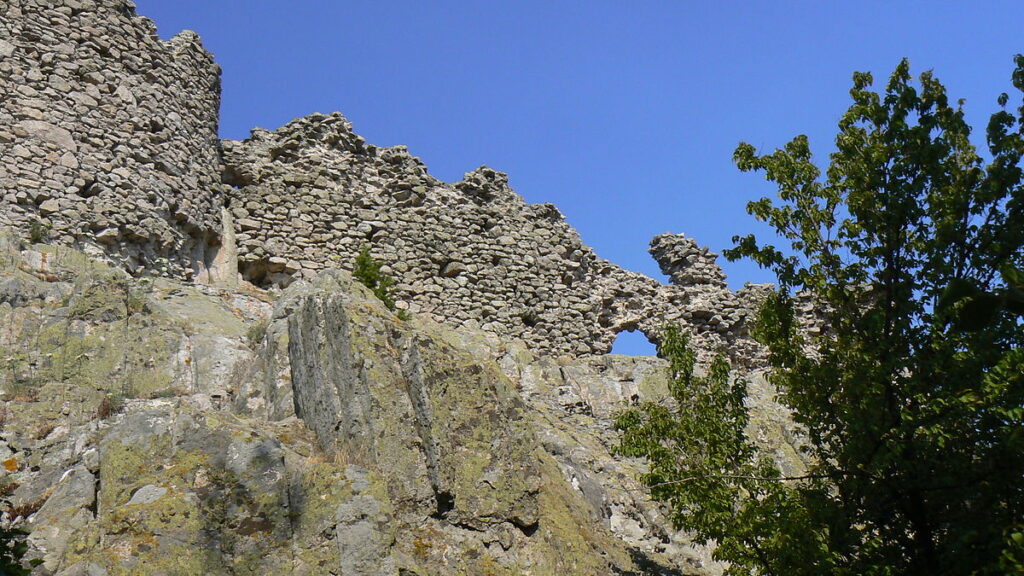
Ustra Castle
Nestled on the Eastern Hilltop of the Rhodope Mountains, the charming remnants of the Ustra fort tell a tale of antiquity. Constructed around the 10th century during the rule of Constantine VII Porphyrogenitus, the fort served as a guardian of a crucial trade route. Although initially captured by the forces of Simeon the Great, the strategically positioned fortress was later restored to Byzantium in exchange for recognising Simeon’s Imperial title by Bulgarian rulers. Throughout the 12th to the 14th century, Ustra fortress frequently changed ownership between the two empires before being deserted in the early 15th century.
The robust walls, fashioned from stone blocks, exhibit remarkable preservation, standing 33 feet at the base and soaring to 370 feet in certain sections. Presently, visitors can marvel at a semicircular tower and two three-story rectangular towers. Ascend the impeccably preserved stairways to gain a panoramic view of the breathtaking surroundings from the pinnacle.
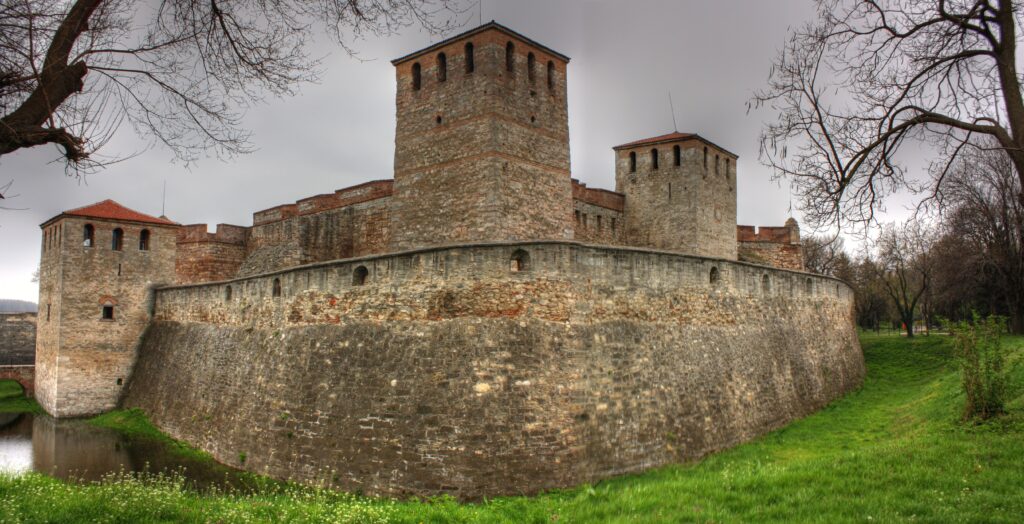
Baba Vida Castle
Baba Vida Castle is another notable fortress in Bulgaria, situated on the bank of the Danube River in the town of Vidin, in the northwest part of the country. Here are some key details about Baba Vida Castle:
- Construction and Origins: Baba Vida is one of the oldest and best-preserved medieval castles in Bulgaria, with its construction dating back to the 10th century. The fortress has undergone various renovations and expansions over the centuries.
- Location: The castle is strategically located on the northwestern tip of Bulgaria, overlooking the Danube River. Its position near the border with Romania highlights its historical importance in defending against potential invasions.
- Architectural Features: Baba Vida Castle is characterised by robust defensive walls, towers, and a moat. The fortress consists of two inner courtyards, with the main citadel containing the residential and administrative buildings. The architecture reflects a mix of styles, including Byzantine, Bulgarian, and Western European influences.
- Historical Significance: The fortress played a crucial role in the defense of the region during different periods of Bulgarian history. It served as a military stronghold against various invaders, including the Ottoman Turks, who eventually captured the castle in the late 14th century.
- Legends and Folklore: Baba Vida Castle is shrouded in legends and folklore, adding to its mystique. One legend suggests that the castle is named after a Bulgarian queen, Baba Vida, who defended the fortress against the invading Ottomans. The stories contribute to the cultural richness surrounding the site.
- Preservation and Tourism: Today, Baba Vida Castle is a popular tourist attraction and a symbol of Vidin. The castle has been well-preserved, allowing visitors to explore its medieval architecture, climb the towers for panoramic views, and learn about its historical significance through exhibitions within the fortress.
- Cultural Heritage Site: Baba Vida Castle has been recognized as a cultural heritage site of national importance in Bulgaria. Its historical and architectural value contributes to the country’s efforts to preserve and showcase its rich cultural heritage.
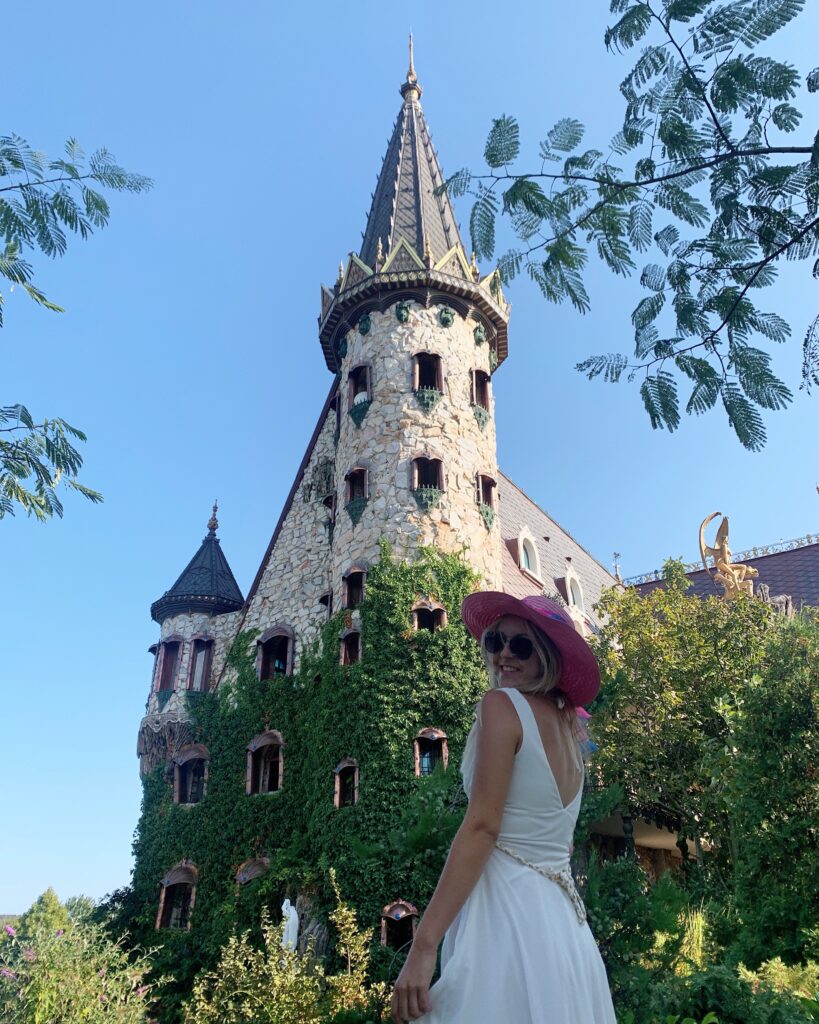
The Castle of Ravadinovo
The Castle of Ravadinovo, also known as In Love with the Wind Castle, is a unique and relatively modern castle located near the town of Sozopol on the Black Sea coast of Bulgaria. Here are some key details about the Castle of Ravadinovo:
- Construction and Ownership: The Castle of Ravadinovo is a private project created by the Bulgarian businessman Georgi Tumpalov. Construction of the castle began in 1996, and it was officially opened to the public in 2009. Tumpalov designed the castle, drawing inspiration from various architectural styles and fairy tales.
- Architectural Style: The castle boasts an eclectic architectural style that combines elements from different historical periods and cultural influences. The design includes features reminiscent of medieval European castles, fairy tale aesthetics, and even elements inspired by the Renaissance.
- Landscaping and Gardens: Surrounding the castle is a vast and beautifully landscaped garden. The gardens feature a variety of plants, sculptures, and water elements, creating a picturesque and whimsical atmosphere. The overall design contributes to the fairy tale ambiance of the castle.
- Chapels and Structures: Within the castle complex, visitors can explore various structures, including chapels, towers, and courtyards. Each section of the castle is meticulously decorated, with attention to detail in architectural embellishments and interior design.
- Artistic Touch: The Castle of Ravadinovo serves as a canvas for artistic expression. Visitors can find numerous sculptures, murals, and other artistic elements throughout the complex. The attention to artistic detail enhances the castle’s fantasy-like ambiance.
- Lake and Bridges: One of the distinctive features of the castle is the artificial lake that surrounds it, complete with stone bridges. The reflections of the castle in the water add to the enchanting atmosphere of the surroundings.
- Events and Tours: The Castle of Ravadinovo is open to the public, offering guided tours that provide insights into its construction, design, and the artistic vision of its creator. The castle also hosts various events, including weddings and cultural performances.
- In Love with the Wind Festival: The castle is known for hosting the “In Love with the Wind” festival, celebrating art, music, and culture. The festival attracts both local and international participants and adds to the cultural vibrancy of the region.
The Castle of Ravadinovo is a fantastic day out for all of the family. Although there are mixed feelings about the commercialised castle among locals, the castle has done an excellent job of offering convenient amenities to visitors, from accessible toilets, as well as restaurants and cafes selling food, drink and quick snacks. Also it’s an ideal place to capture a few snaps for Instagram!

Nesebar Fortifications
Nesebar, a historic town on the Black Sea coast of Bulgaria, boasts well-preserved fortifications that bear witness to its rich history. Here are key details about the Nesebar fortifications:
- Geographical Location: Nesebar is situated on a small peninsula in the Black Sea, connected to the mainland by a narrow isthmus. The town is known for its ancient architecture and historical significance.
- Historical Significance: The fortifications in Nesebar have a long history, dating back to ancient times. The town has been inhabited by various civilisations, including the Thracians, Greeks, Romans, Byzantines, and Bulgarians.
- UNESCO World Heritage Site: Nesebar’s Old Town, including its fortifications, is a UNESCO World Heritage Site. The town is recognised for its well-preserved medieval architecture and its role as a cultural crossroads.
- Medieval Walls and Towers: The medieval fortifications of Nesebar consist of sturdy walls and defensive towers that were constructed during different historical periods. These walls provided protection to the town against invasions and attacks.
- Byzantine Influence: The Byzantines, who played a significant role in the history of Nesebar, left a lasting impact on the fortifications. The town served as a Byzantine stronghold, and elements of their architectural style are evident in the walls and towers.
- Churches and Monasteries: Within the fortified area of Nesebar, there are numerous churches and monasteries that add to the historical and cultural significance of the site. These religious structures are adorned with frescoes and intricate architectural details.
- Ottoman Period: During the Ottoman era, Nesebar continued to exist, and the fortifications underwent modifications to adapt to changing military technologies. The Ottomans left their mark on the town’s architecture and culture.
- Well-Preserved Condition: The fortifications of Nesebar are remarkably well-preserved, allowing visitors to stroll along the ancient walls and explore the defensive structures. The town’s ability to retain its historic character contributes to its allure.
- Tourist Attraction: Nesebar’s fortifications are a major tourist attraction, drawing visitors from around the world. The combination of historical charm, seaside location, and cultural heritage makes Nesebar a must-visit destination on the Bulgarian Black Sea coast.
Nesebar is easy to get to if you head to the Sunny Beach area on Bulgaria’s Black Sea coast. If you land at Burgas airport, the drive to Nesebar should only take around 40-50 minutes. It’s the next town on from Sunny Beach and is only a 10 minute drive away from the hustle and bustle of Sunny Beach.
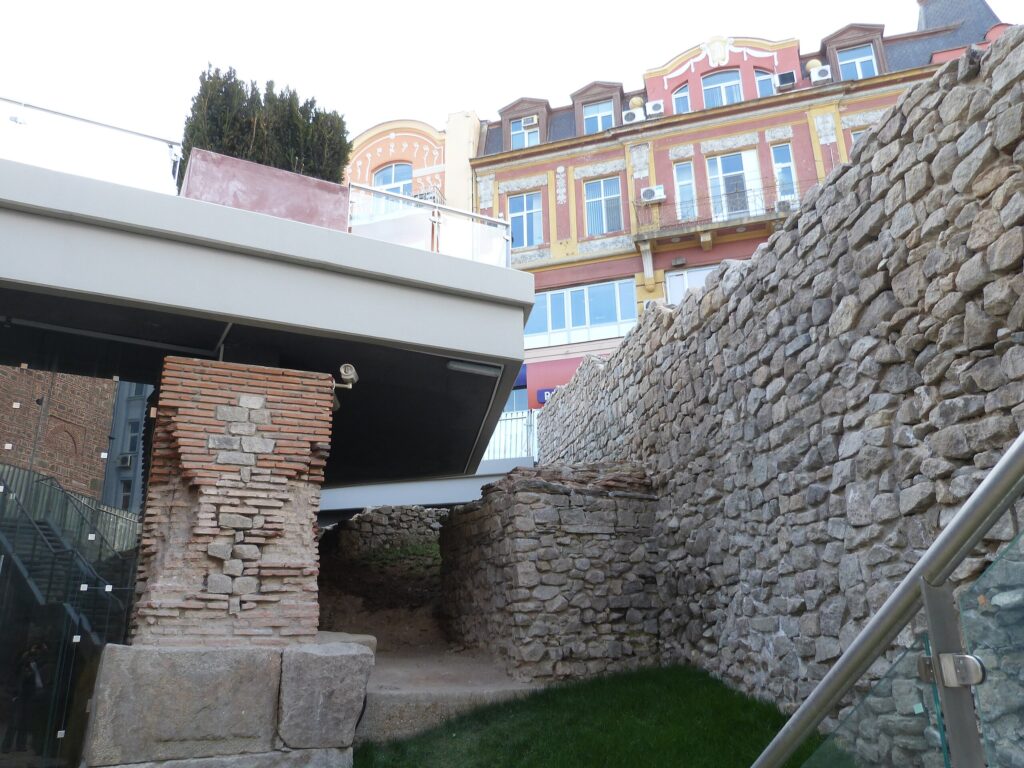
Plovdiv Fortifications
Ovech Fortress
Nestled on the Kaleto mountain plateau, Ovech Fortress, an architectural marvel shaped like a Byzantine ship dating back to the 4th century, unfolds its historical narrative.
Throughout the initial era of the First Bulgarian Empire, Ovech Fortress stood as a hub for administration and culture. Transitioning into the 14th century during the Second Bulgarian Empire, it evolved into a pivotal military and administrative stronghold. In 1388, after a protracted siege, the Ottomans triumphed, transforming the fortress into a bustling commercial centre that flourished during the 17th and 18th centuries.
Wandering through the remnants of this storied site, visitors can immerse themselves in the echoes of the past, exploring the intriguing ruins of the Friars’ Holes, Knight’s Prison, Bishop’s Tower, and the grain tanks. Each structure whispers tales of the fortress’s multifaceted history and the civilisations that once thrived within its formidable walls.
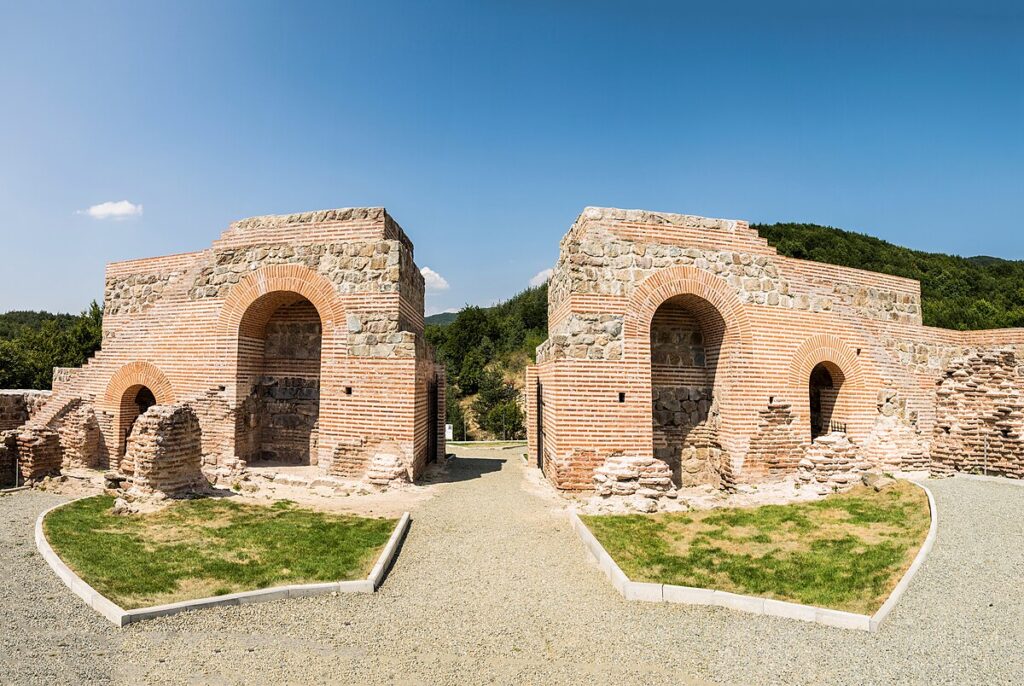
Gate of Trajan Fortress
Following the victorious conquest of Northwestern Thrace, the initial fortress was erected by the Romans in this area. Positioned strategically on the mountain pass connecting Thrace and Sofia, this fortress gained renown for the pivotal clash occurring on 17 August 986. In this historic battle, Tsar Samuil of Bulgaria emerged triumphant, thwarting the Byzantine Emperor Basil I’s invasion and safeguarding Bulgaria from occupation. Greek historians have recounted this event, asserting that the “Bulgarians’ arrows proved mightier than the spears of the Byzantines.”

Peristera Fortress
In the 4th century, the Thracians initially inhabited a Sanctuary, a site whose excavations have revealed its historical depth, a narrative confirmed by the discovery of funerary urns.
Perched on St. Petka Hill, the fortress offers a splendid vantage point, strategically positioned to safeguard against potential invaders. This defensive significance is evident in the fortress’s layout, featuring a citadel encircled by three distinct enclosures, each separated by defensive walls.
The fortified expanse of the fortress spans 9498 square feet, with robust walls connecting six towers and stretching a total length of 830 feet. These formidable fortifications stand as both a testament to ancient defensive strategies and a window into the historical landscape of the region.
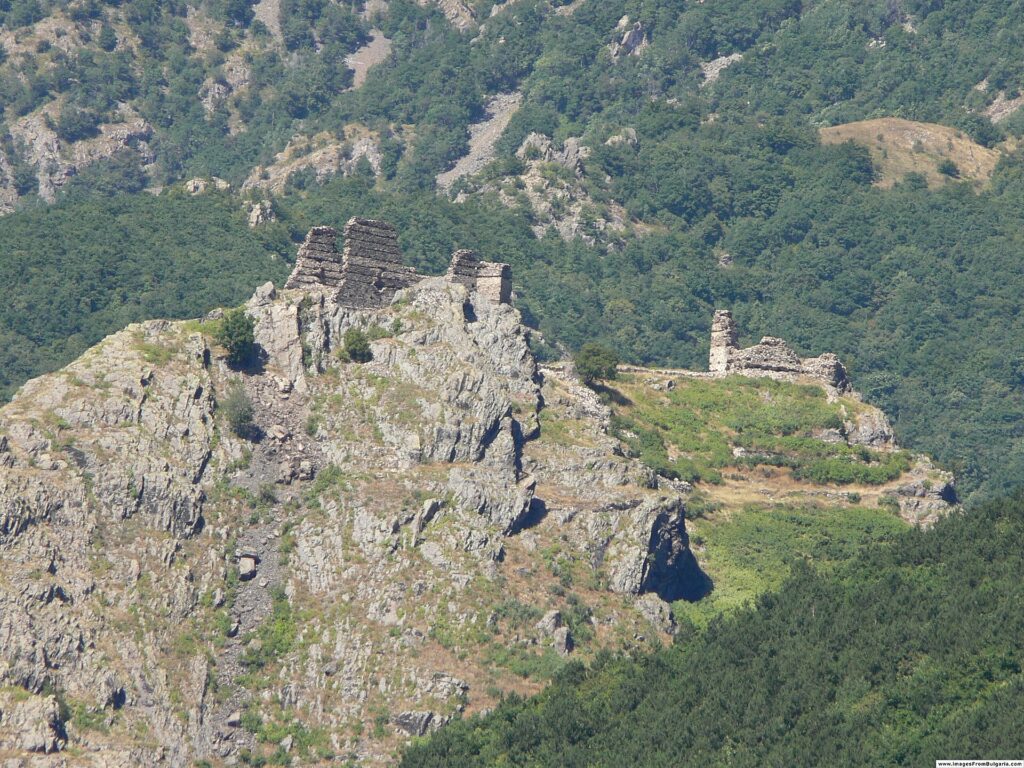
Anevo Fortress
Situated on a steep hill at the southern base of the Balkan Mountains, approximately two miles from the village of Anevo, lies Anevo Fortress, also known as Kopsis Fortress. Renowned as one of Bulgaria’s remarkably well-preserved strongholds, this site has a rich history dating back to the 3rd century, initially serving as a stronghold for the ancient Romans and later utilized by the Byzantines in the 5th to 6th century. Archaeological excavations within the inner city have unveiled residential structures and two churches adorned with Medieval period frescoes.
During a brief period of quasi-independence, the fortress was fortified by the renegade brothers Vovosil and Radoslav, under the rule of Tsar Smilets of Bulgaria. The expansive original complex covered an area of about 86,000 square feet, with the inner town spanning 54,000 square feet. Two towers, along with a 328-feet-long curtain wall, still proudly stand today. Named after Tsar Ivan Asen II, who oversaw its reconstruction in 1230, Asen Fortress perches on a rocky outcrop above the Asenitsa River, providing a strategic vantage point 915 feet above the river to thwart potential Roman invasions.
The archaeological timeline of Anevo Fortress spans from the Thracian era through Ancient Roman, early Byzantine, and Crusades, culminating in its eventual conquest and destruction by the invading Ottomans. Unearthed remnants include a feudal castle featuring 30 rooms and notably three water repositories designed for mountain water. While the Ottomans destroyed much of the fortress, the enduringly beautiful brick church, “The Holy Mother of God,” remains in active use by the Bulgarian Orthodox Church. Within the chapel, meticulously restored murals from the 14th century grace the walls, providing a poignant glimpse into the historical and cultural tapestry of Anevo Fortress.
Cherven Fortress
Hisarlaka Fortress
From the 5th to the 15th centuries, Hisarlaka Fortress served as the pivotal administrative and religious hub of its region. Erected over the course of ten centuries by various rulers, the fortress evolved into a grand structure boasting fourteen towers and formidable curtain walls. Its irregular polygonal shape and the varied designs of the surrounding towers, ranging from circular and triangular to rectangular, showcase the diverse architectural and defensive styles employed across different epochs. Witnessing the epochs of both the first and second Bulgarian Kingdoms, this formidable stronghold withstood numerous assaults until finally succumbing to the Ottoman Empire in the 15th century.

Mezek Fortress
Mezek Fortress, also known as Mezek Tumulus, is a historical site located in the southern part of Bulgaria, near the village of Mezek in the Haskovo Province. Here are key details about Mezek Fortress:
- Geographical Location: Mezek Fortress is situated in the Thracian Valley, close to the border with Greece and Turkey. It occupies a strategic position overlooking the surrounding plains.
- Historical Significance: The fortress has a rich history, dating back to the ancient Thracian period. It played a role in various historical eras, including the Byzantine, Bulgarian, and Ottoman periods.
- Thracian Origins: The origins of Mezek Fortress can be traced to the Thracian civilisation. The Thracians, an ancient Indo-European people, inhabited this region, leaving behind traces of their culture and fortifications.
- Medieval Period: During the medieval period, Mezek Fortress gained importance as a defensive stronghold. It was strategically positioned to control trade routes and provide protection against invasions.
- Architecture and Features: The fortress features well-preserved walls and towers, showcasing medieval military architecture. The site includes a combination of inner and outer walls, as well as a central tower. Archaeological excavations have revealed the presence of a medieval church within the fortress.
- Wine Production: Mezek is renowned for its winemaking tradition, and the region around the fortress is known for vineyards. The historical connection between the fortress and viticulture adds to the cultural significance of Mezek.
- Archaeological Discoveries: Archaeological studies around Mezek Fortress have unearthed artefacts from different periods, shedding light on the various civilisations that inhabited the area.
- Tourist Attraction: Today, Mezek Fortress is a popular tourist attraction, drawing visitors with its historical significance, architectural remnants, and the scenic landscape. The site offers a glimpse into Bulgaria’s diverse cultural and historical heritage.
- Mezek Tumulus: In addition to the fortress, there is a nearby ancient Thracian burial mound, known as the Mezek Tumulus. Tumuli were often associated with Thracian burial practices, and this particular mound contributes to the archaeological wealth of the region.
Mezek Fortress stands as a testament to the cultural layers that have shaped Bulgaria over the centuries, with influences from the Thracians, Byzantines, Bulgarians, and Ottomans. Visitors to the site can explore the impressive remains of the fortress and appreciate its historical significance.
Hisarya City Walls
The twenty-two thermal springs in Hisarya have been harnessed for their healing properties since as early as the 4th century BCE. The therapeutic mineral waters, coupled with a temperate climate, transformed this ancient city into an alluring destination for the Roman Empire, eventually leading to its conquest in 46 AD.
In the year 293 AD, Emperor Diocletian left an indelible mark by renaming the city after himself, christening it Diocletianopolis. Under his reign, what was once a modest settlement blossomed into a prestigious Roman city. Diocletian orchestrated the construction of magnificent Roman bathhouses, the paving of streets, and the fortification of city walls.
Remarkably, these expansive city walls remain nearly intact after two millennia, a testament to the enduring legacy of Roman engineering that continues to captivate observers today.
Matochina Castle

Palace of Balchik
The Palace of Balchik, also known as the Balchik Palace or the Quiet Nest Palace, is a historic residence located in the town of Balchik on the northern coast of the Black Sea in Bulgaria. Here are some key details about the Palace of Balchik:
- Origins and Ownership: The palace has a diverse history, with its origins traced back to the early 20th century. Originally, it was built as a summer residence for the Romanian Queen Marie of Edinburgh, who fell in love with the picturesque coastal town of Balchik during her visit.
- Architectural Style: The Palace of Balchik reflects a unique blend of architectural styles, incorporating elements of Romanian, Bulgarian, and Oriental design. The complex includes various buildings, lush gardens, and decorative elements that showcase the eclectic taste of Queen Marie.
- Gardens and Landscaping: One of the most notable features of the palace is its extensive botanical gardens. Queen Marie, who had a deep appreciation for nature, personally contributed to the design of the gardens. The grounds are adorned with a variety of plants, flowers, and sculptures, creating a serene and picturesque environment.
- The Main Building: The main building of the palace consists of several interconnected villas, each with its own unique design and purpose. The architectural layout allows for panoramic views of the Black Sea and the surrounding landscape.
- The Minaret: Another distinctive feature of the palace is the minaret, a remnant from the Ottoman era when the site was initially used as a summer residence for Ottoman rulers. Queen Marie decided to keep the minaret as part of the eclectic charm of the palace.
- Cultural Significance: The Palace of Balchik has cultural significance not only for its architectural and natural beauty but also for its role in fostering cultural exchanges between Romania and Bulgaria during the early 20th century.
- Post-World War II Era: After World War II, the palace became a state property under the control of the Bulgarian government. It was opened to the public, allowing visitors to explore the architectural marvels, lush gardens, and historical artefacts within the complex.
- Tourist Attraction: Today, the Palace of Balchik is a popular tourist attraction, drawing visitors from Bulgaria and beyond. The site offers a unique blend of history, architecture, and natural beauty, making it a must-visit destination on the Bulgarian Black Sea coast.
Balchik is easily reachable from the coastal city of Varna, situated on the northern Black Sea Coast in Bulgaria. If you fly to Varna airport, you can easily access Balchik through a variety of public transport links.




